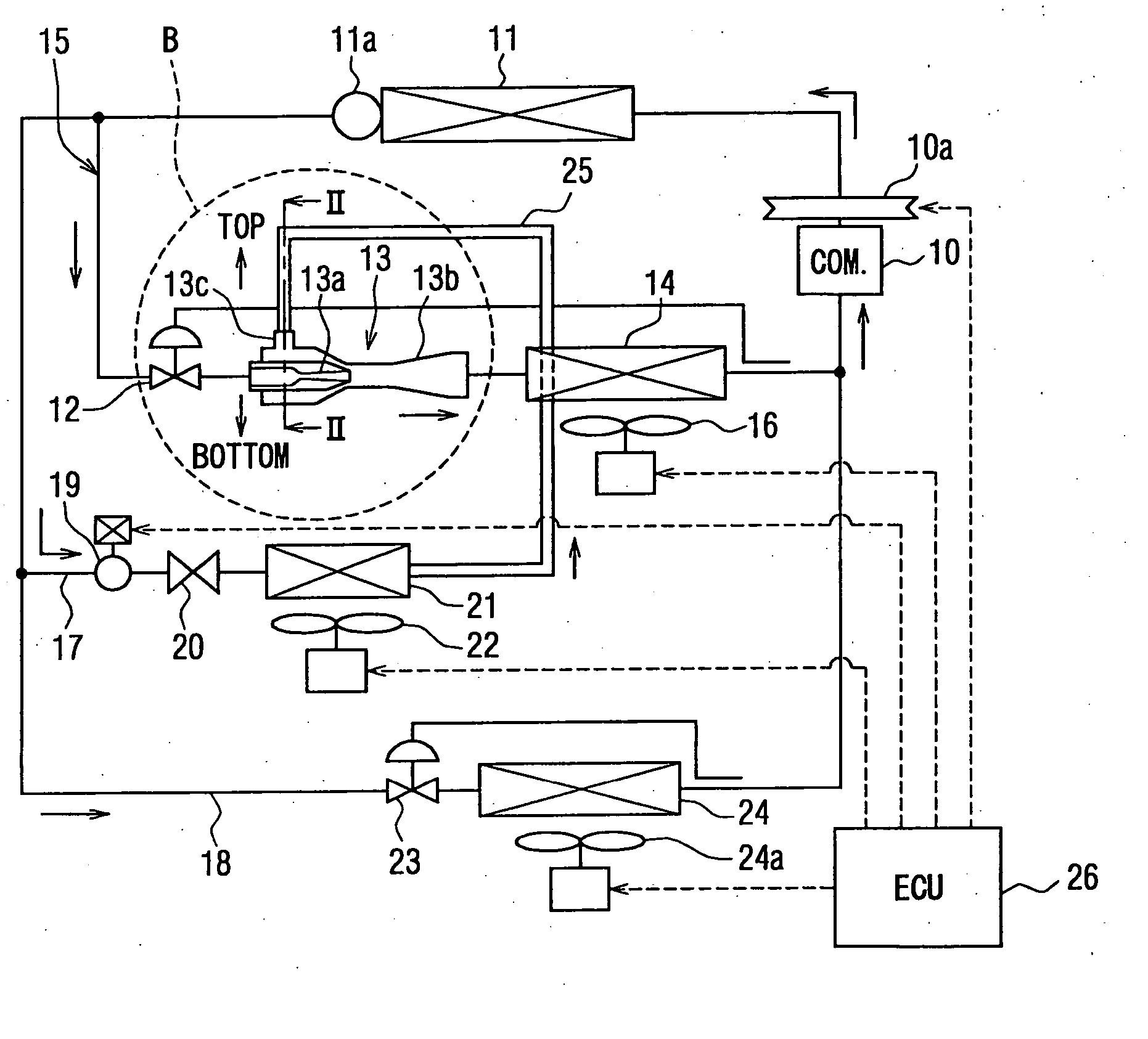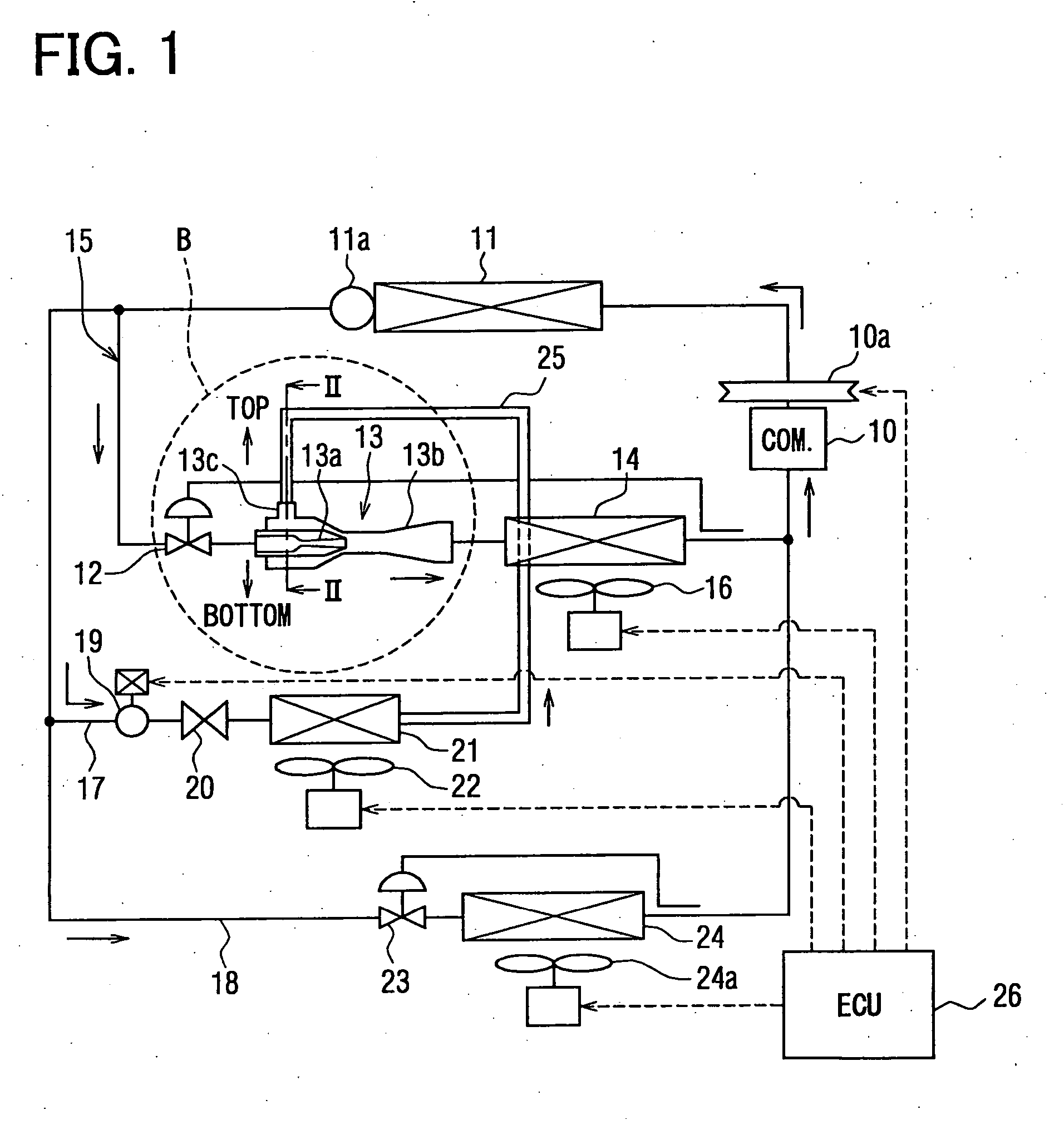Vapor-compression refrigerant cycle system with ejector
a technology of refrigerant cycle and ejector, which is applied in refrigeration components, transportation and packaging, light and heating equipment, etc., can solve the problems of lubrication oil shortage in the compressor, reduced lubrication oil return amount, etc., to prevent lubrication oil shortage, and improve the lubrication property of the compressor
- Summary
- Abstract
- Description
- Claims
- Application Information
AI Technical Summary
Benefits of technology
Problems solved by technology
Method used
Image
Examples
first embodiment
[0032] In the first embodiment, a vapor-compression refrigerant cycle system having an ejector, shown in FIG. 1, is typically used for a vehicle air conditioner, as an example. The vapor-compression refrigerant cycle system includes a main refrigerant path 15 in which refrigerant flows in this order of a discharge side of a compressor 10, a refrigerant radiator 11, a flow adjustment valve 12, an ejector 13, a first evaporator 14 and a suction side of the compressor 10.
[0033] In this embodiment, the compressor 10 for compressing refrigerant is driven and rotated by a vehicle engine through a belt and an electromagnetic clutch 10a, etc. The operation of the compressor 10 is switched and controlled by the electromagnetic clutch 10a. In this case, by controlling an on / off operation ratio of the compressor 10, a refrigerant discharge capacity of the compressor 10 can be controlled.
[0034] The refrigerant radiator 11 cools high-pressure refrigerant discharged from the compressor 10 by pe...
second embodiment
[0069] In the above-described first embodiment, the refrigerant suction port 13c of the ejector 13 is provided at an upper portion of the housing 13d. However, in the second embodiment, the refrigerant suction port 13c is provided at a lower portion of the housing 13d, and a standing portion 25a extending in a vertical direction is formed at a downstream portion in the refrigerant suction pipe 25, as shown in FIG. 4. The standing portion 25a can be vertically extended upwardly from a lowest portion of the ejector 13 by a predetermined height. In FIG. 4, H2 indicates the height of the standing portion 25a vertically extended.
[0070] In this embodiment, a downstream pipe portion downstream from the standing portion 25a in the refrigerant suction pipe 25 can be made shorter. Accordingly, even when the refrigerant suction portion 13c is arranged at the lower portion (e.g., bottom portion) of the housing 13d, the lubrication amount staying in the refrigerant suction pipe 25 can be contro...
third embodiment
[0073]FIG. 5 shows a vapor-compression refrigerant cycle system of the third embodiment. In the third embodiment, the electromagnetic valve 19 is not provided in the first branch passage 17, and refrigerant flowing from the main refrigerant circulating path 15 flows into the second evaporator 21 in the first branch portion 17 after passing through the throttle mechanism 20. Therefore, when the compressor 10 is operated, refrigerant always flows into the second evaporator 21 in the first branch passage 17.
[0074] Thus, in this embodiment, when the refrigerator function (refrigerator cooling operation) is stopped, the operation of the second blower 22 is stopped. When the second blower 22 is stopped, a heat absorbing amount of the refrigerant in the second evaporator 2 is very small, and a large amount of the liquid refrigerant having passed through the throttle mechanism 20 is drawn into the refrigerant suction port of the ejector 13 without being evaporated in the second evaporator ...
PUM
 Login to View More
Login to View More Abstract
Description
Claims
Application Information
 Login to View More
Login to View More - R&D
- Intellectual Property
- Life Sciences
- Materials
- Tech Scout
- Unparalleled Data Quality
- Higher Quality Content
- 60% Fewer Hallucinations
Browse by: Latest US Patents, China's latest patents, Technical Efficacy Thesaurus, Application Domain, Technology Topic, Popular Technical Reports.
© 2025 PatSnap. All rights reserved.Legal|Privacy policy|Modern Slavery Act Transparency Statement|Sitemap|About US| Contact US: help@patsnap.com



